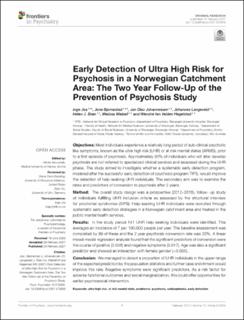| dc.contributor.author | Joa, Inge | |
| dc.contributor.author | Bjørnestad, Jone Ravndal | |
| dc.contributor.author | Johannessen, Jan Olav | |
| dc.contributor.author | Langeveld, Johannes Hendrik | |
| dc.contributor.author | Stain, Helen J. | |
| dc.contributor.author | Weibell, Melissa Anne Elin Authen | |
| dc.contributor.author | Hegelstad, Wenche | |
| dc.coverage.spatial | Norway | en_US |
| dc.date.accessioned | 2021-05-25T12:20:51Z | |
| dc.date.available | 2021-05-25T12:20:51Z | |
| dc.date.created | 2021-03-17T21:28:19Z | |
| dc.date.issued | 2021-02 | |
| dc.identifier.citation | Joa, I., Bjørnestad, J., Johannessen, J.O. et al. (2021) Early detection of ultra high risk for psychosis in a Norwegian catchment area: The two year follow-up of the Prevention of Psychosis study. Frontiers in Psychiatry, DOI: 10.3389/fpsyt.2021.573905 | en_US |
| dc.identifier.issn | 1664-0640 | |
| dc.identifier.uri | https://hdl.handle.net/11250/2756314 | |
| dc.description.abstract | Objectives: Most individuals experience a relatively long period of sub-clinical psychotic like symptoms, known as the ultra high risk (UHR) or at risk mental states (ARMS), prior to a first episode of psychosis. Approximately 95% of individuals who will later develop psychosis are not referred to specialized clinical services and assessed during the UHR phase. The study aimed to investigate whether a systematic early detection program, modeled after the successful early detection of psychosis program TIPS, would improve the detection of help-seeking UHR individuals. The secondary aim was to examine the rates and predictors of conversion to psychosis after 2 years.
Method: The overall study design was a prospective (2012–2018), follow- up study of individuals fulfilling UHR inclusion criteria as assessed by the structural interview for prodromal syndromes (SIPS). Help-seeking UHR individuals were recruited through systematic early detection strategies in a Norwegian catchment area and treated in the public mental health services.
Results: In the study period 141 UHR help-seeking individuals were identified. This averages an incidence of 7 per 100,000 people per year. The baseline assessment was completed by 99 of these and the 2 year psychosis conversion rate was 20%. A linear mixed-model regression analysis found that the significant predictors of conversion were the course of positive (0.038) and negative symptoms (0.017). Age was also a significant predictor and showed an interaction with female gender (<0.000).
Conclusion: We managed to detect a proportion of UHR individuals in the upper range of the expected prediction by the population statistics and further case enrichment would improve this rate. Negative symptoms were significant predictors. As a risk factor for adverse functional outcomes and social marginalization, this could offer opportunities for earlier psychosocial intervention. | en_US |
| dc.language.iso | eng | en_US |
| dc.publisher | Frontiers Media S.A | en_US |
| dc.rights | Navngivelse 4.0 Internasjonal | * |
| dc.rights.uri | http://creativecommons.org/licenses/by/4.0/deed.no | * |
| dc.subject | psykose | en_US |
| dc.title | Early detection of ultra high risk for psychosis in a Norwegian catchment area: The two year follow-up of the Prevention of Psychosis study | en_US |
| dc.type | Peer reviewed | en_US |
| dc.type | Journal article | en_US |
| dc.description.version | publishedVersion | en_US |
| dc.rights.holder | © 2021 Joa, Bjornestad, Johannessen, Langeveld, Stain, Weibell and Hegelstad. | en_US |
| dc.subject.nsi | VDP::Medisinske Fag: 700::Klinisk medisinske fag: 750::Psykiatri, barnepsykiatri: 757 | en_US |
| dc.source.journal | Frontiers in Psychiatry | en_US |
| dc.identifier.doi | 10.3389/fpsyt.2021.573905 | |
| dc.identifier.cristin | 1898855 | |
| cristin.ispublished | true | |
| cristin.fulltext | original | |
| cristin.qualitycode | 1 | |

